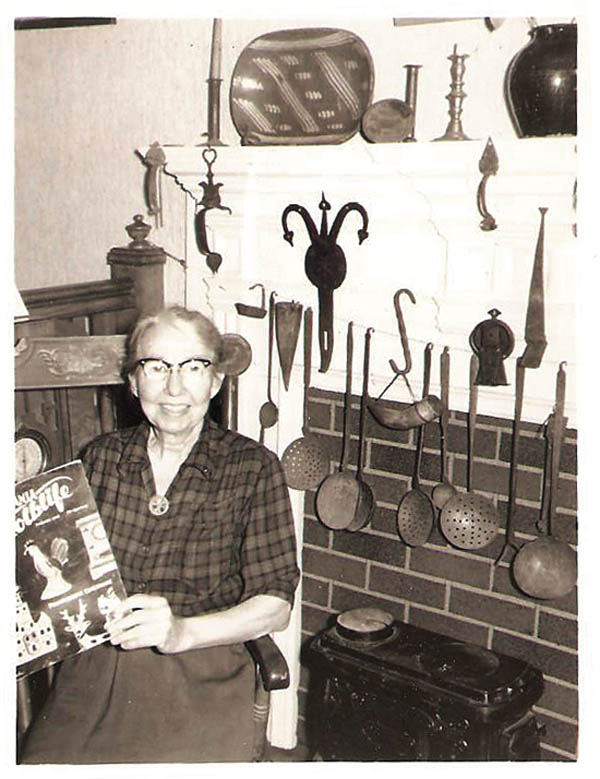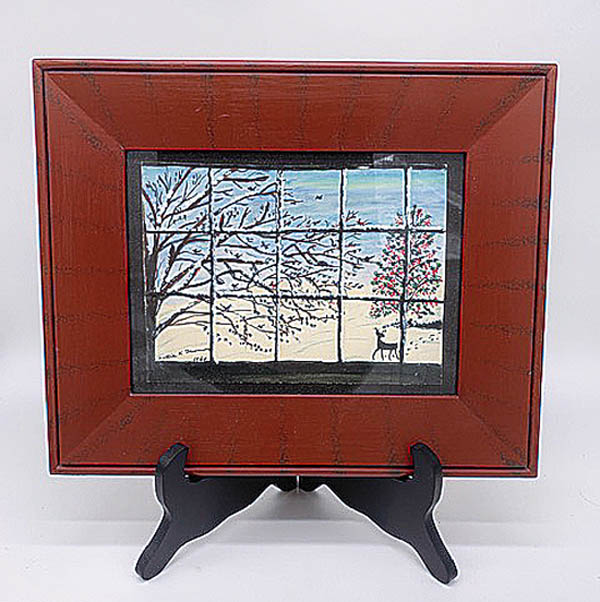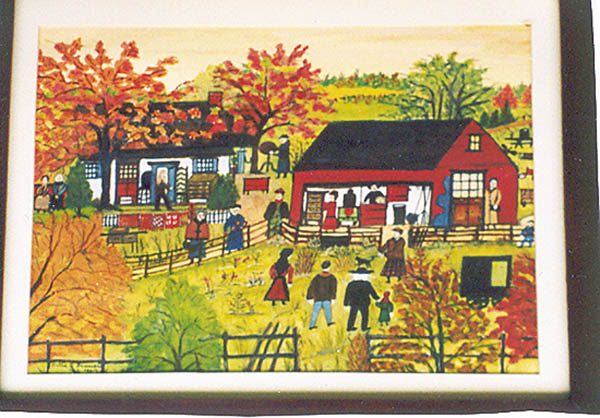A Profile In Pennsylvania German Studies
Hattie Klapp Brunner (1889-1982)
By Jan Swinehart - April 29, 2022
Hattie Klapp Brunner was born in East Cocalico Township on Nov. 27, 1889, to Abiram and Mary Weinhold Klapp. The Klapps resided in Vera Cruz, a small village located along Route 897 near Reinholds, Pa. In 1917, Hattie received her Teachers Certificate from the Philadelphia Musical Academy, and not long after, she married Raymond Brunner. She taught piano and held student concerts in their residence in Reinholds. She also sang soprano in the Swamp Reformed Church choir and was the churchs organist from 1917-33. Her mother-in-law, Hattie Sweigart Brunner, was an antiques dealer. Hattie followed suit in the business, opening her antiques shop The Tulip Shop in the early 1930s. It was a career that ran roughly half a century. She passed away Aug. 2, 1982. Today, Hattie is remembered as an antiques dealer and as an artist. Hatties interest in buying and selling antiques began at an early age. Developing an interest in Pennsylvania German items, she became an antique dealer, not as a hobby, but as a relevent and dominate position in the marketplace. Her reputation as an authoritative source on Pennsylvania German decorative arts gained national recognition from museums, artists, art dealers, and, of course, collectors. Hattie contributed to the extensive Pennsylvania German collections being formed by prominent individuals such as Henry Francis du Pont, Dr. Albert Barnes, George Lorimer, Bernice Chrysler Garbisch, Walter Himmelreich, Titus Geesey, and Cornelius Weygandt. Hattie had a unique way of documenting purchase price and sales. On correspondence she sometimes used a secret code containing symbols that correlated to a specific number. An example of the code appears on an invoice with Dr. Albert Barnes. The code is MARYILOVEU. The first letter M represents $1, A represents $2, the R $3, so forth, $1 to $10. However, some characters are random and meaningless. The top line is her cost. It is A1X. The bottom line, what she sold item for, R1F. So, A means $2 and R means $3. She realized a $1 profit. A1X R1F This reference is not to paint the picture she just sold low value trinkets. Some very high dollar significant material changed hands from Brunner to Barnes. The cornerstones of the Barnes Foundations Pennsylvania German collection came from Brunner, much of it during the war years in the 1940s. Her art career didnt begin until the late 1950s. Hattie began painting roughly at age 67, receiving no formal artistic instruction. Hattie painted over 500 watercolors, with the majority being pastoral landscapes. Hatties landscape paintings illustrate a slightly exaggerated yet quintessential life depicting farm scenes and country events with a flurry of activity that is often repeated in different seasons of the year. She drew from experiences traveling the local countryside, everyday living, and recollections of childhood pastimes to capture the natural settings of her community. Country sale paintings often included personal acquaintances and sometimes herself. Describing a country sale painting, Hattie once stated, Thats me. Im the one looking at the tilt-top table. Thats Joe Kindig near the high backed chair. In several of the self-portraits, Hattie adorns a black cape and hat. A few topics were produced in limited number, such as Making Applebutter, ca. 1960, quilting bees, and interior scenes. She was sometimes criticized for producing too many winter scenes. Hattie once responded to the criticism by stating, That is what people wanted. Hattie Brunners art is a vital link to her past, exemplifying a rural traditional lifestyle. She documented the life lived in the farming community, creating a historical record which included a key aspect of Hatties early years looking for fine Pennsylvania German furniture, arts, and crafts. The popularity of her images, the cultural and pastoral nostalgia of years gone illustrated in her paintings is a significant legacy of her life. Hattie would probably be surprised at the value of her paintings and what they bring in todays marketplace. Prices have increased over the past several years. In 2018, a winter scene and farm scene sold for $3,200 and $4,880, respectively. In 2020, a large summer farm scene brought $18,000. An auction scene recently sold (Feb. 12, 2022) at Horst Auction Center for $23,500, setting a new auction record for her work. Based on current auction market activity, it is evident the interest for her artwork is strong. References: Swinehart, Jan. Hattie Brunner Memory Painter. Thesis. Pennsylvania State University, 2009. Pass, Karl. The Kempton Show: 2018 Edition. Antiques & Auction News. Nov. 23, 2018. Vol. 49, No. 47. Pass, Karl. Flack Sale Proves Pennsylvania German Folk Ark Remains A Viable Market. Antiques & Auction News. Dec. 7, 2018. Pass, Karl. Two-Day Sale at Horst. Antiques & Auction News. March 18, 2022. Vol. 52, No.11.








SHARE
PRINT